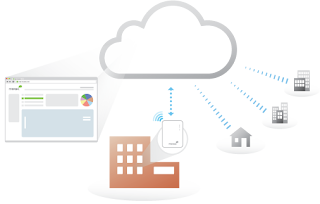 To connect to a Wi-Fi LAN, a computer has to be equipped with a wireless network interface controller. The combination of computer and interface controller is called a station. All stations share a single radio frequency communication channel. Transmissions on this channel are received by all stations within range. The hardware does not signal the user that the transmission was delivered and is therefore called a best-effort deliverymechanism. A carrier wave is used to transmit the data in packets, referred to as "Ethernet frames". Each station is constantly tuned in on the radio frequency communication channel to pick up available transmissions.
To connect to a Wi-Fi LAN, a computer has to be equipped with a wireless network interface controller. The combination of computer and interface controller is called a station. All stations share a single radio frequency communication channel. Transmissions on this channel are received by all stations within range. The hardware does not signal the user that the transmission was delivered and is therefore called a best-effort deliverymechanism. A carrier wave is used to transmit the data in packets, referred to as "Ethernet frames". Each station is constantly tuned in on the radio frequency communication channel to pick up available transmissions.Internet access
A Wi-Fi-enabled device can connect to the Internet when within range of a wireless network which is configured to permit this. The coverage of one or more (interconnected) access points — called hotspots — can extend from an area as small as a few rooms to as large as many square miles. Coverage in the larger area may require a group of access points with overlapping coverage. Outdoor public Wi-Fi technology has been used successfully in wireless mesh networks in London, UK.
Wi-Fi provides service in private homes, high street chains and independent businesses, as well as in public spaces at Wi-Fi hotspots set up either free-of-charge or commercially. Organizations and businesses, such as airports, hotels, and restaurants, often provide free-use hotspots to attract customers. Enthusiasts or authorities who wish to provide services or even to promote business in selected areas sometimes provide free Wi-Fi access.
Routers that incorporate a digital subscriber line modem or a cable modem and a Wi-Fi access point, often set up in homes and other buildings, provide Internet access and internetworking to all devices connected to them, wirelessly or via cable.
Similarly, there are battery-powered routers that include a cellular mobile Internet radiomodem and Wi-Fi access point. When subscribed to a cellular phone carrier, they allow nearby Wi-Fi stations to access the Internet over 2G, 3G, or 4G networks. Many smartphones have a built-in capability of this sort, including those based on Android, Bada, iOS (iPhone), Windows Phone andSymbian, though carriers often disable the feature, or charge a separate fee to enable it, especially for customers with unlimited data plans. "Internet packs" provide standalone facilities of this type as well, without use of a smartphone; examples include the MiFi- and WiBro-branded devices. Some laptops that have a cellular modem card can also act as mobile Internet Wi-Fi access points.
Wi-Fi also connects places that normally don't have network access, such as kitchens and garden sheds.
City-wide Wi-Fi
In the early 2000s, many cities around the world announced plans to construct city-wide Wi-Fi networks. There are many successful examples; in 2004,Mysore became India's first Wi-Fi-enabled city and second in the world after Jerusalem. A company called WiFiyNet has set up hotspots in Mysore, covering the complete city and a few nearby villages.
In 2005, Sunnyvale, California, became the first city in the United States to offer city-wide free Wi-Fi. Minneapolis has generated $1.2 million in profit annually for its provider.
In May 2010, London, UK, Mayor Boris Johnson pledged to have London-wide Wi-Fi by 2012. Several boroughs including Westminster and Islington already have extensive outdoor Wi-Fi coverage.
Officials in South Korea's capital are moving to provide free Internet access at more than 10,000 locations around the city, including outdoor public spaces, major streets and densely populated residential areas. Seoul will grant leases to KT, LG Telecom and SK Telecom. The companies will invest $44 million in the project, which will be completed in 2015.
Campus-wide Wi-Fi
Many traditional college campuses in the United States provide at least partial wireless Wi-Fi Internet coverage. Carnegie Mellon University built the first campus-wide wireless Internet network, called Wireless Andrew, at its Pittsburgh campus in 1993 before Wi-Fi branding originated. In Europe many universities collaborate in providing Wi-Fi access to students and staff through the eduroam international authentication infrastructure.
In 2000, Drexel University in Philadelphia became the United States' first major university to offer completely wireless Internet access across its entire campus. The Far Eastern University inManila is the first university in the Philippines to implement a campus-wide Wi-Fi coverage.
Direct computer-to-computer communication
Wi-Fi also allows communications directly from one computer to another without an access point intermediary. This is called ad hoc Wi-Fi transmission. This wireless ad hoc network mode has proven popular with multiplayer handheld game consoles, such as the Nintendo DS, PlayStation Portable, digital cameras, and other consumer electronics devices. Some devices can also share their Internet connection using ad-hoc, becoming hotspots or "virtual routers".
Similarly, the Wi-Fi Alliance promotes a specification called Wi-Fi Direct for file transfers and media sharing through a new discovery- and security-methodology. Wi-Fi Direct launched in October 2010.




No comments:
Post a Comment